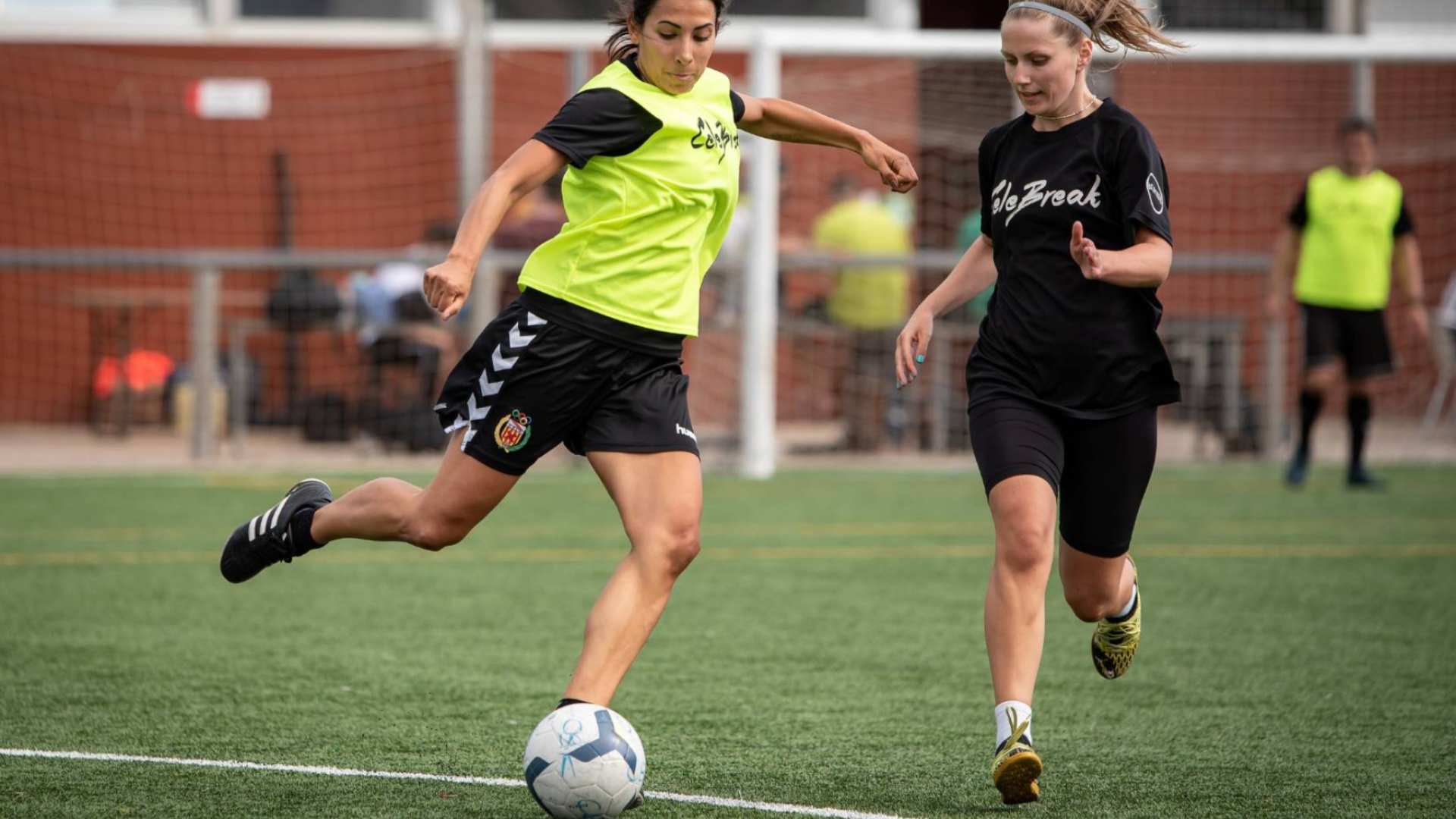Sprains are a common injury in any sport, but do you know how sprains happen in soccer? In this article, we’ll explore the mechanisms behind these injuries, how to treat them, and what steps you can take to prevent them.
Soccer is exciting, but, like any physical sport, players are exposed to risks and injuries.
From minor bruises to fractures, those involved in a match can sustain injuries on the pitch.
One of the most common injuries in soccer is a sprain, especially an ankle sprain.
The fast-paced, intensive nature of the game, along with movements such as spins, jumps, and side steps, make sprains a frequent occurrence.
But how exactly do these soccer sprains happen? What can be done to treat them and, more importantly, prevent them?
What is a sprain?
A sprain is an injury when one or more ligaments, the strong bands of tissue that connect bones, are stretched or torn.
These injuries can happen to any joint but are especially common in the ankles and wrists.
A sprain usually occurs when the joint is forced beyond its normal range of motion, such as when you make a sharp turn, fall, or receive a direct impact.
Prevalence of sprains in soccer
In the case of soccer, sprains, particularly ankle sprains, are one of the most common injuries.
According to several investigations, they represent between 10% and 30% of all injuries in this sport.
This is due to the nature of soccer, which involves running, spinning, jumping, and colliding with other players, which puts great stress on the ligaments.
Also, uneven terrain or slippery surfaces can increase the risk of spraining.
Therefore, all players must understand how soccer sprains happen, how they can be treated, and, most importantly, how they can be prevented.
How football sprains happen
In soccer, ankle sprains are often caused by specific injury mechanisms.
A common cause is ankle twisting, when the foot is turned in or out with too much force, stretching, or tearing the ligaments.
This type of injury can happen from changing direction quickly, landing incorrectly after a jump, or tripping or falling.
Another frequent form of injury is through contact with other players.
For example, a sprain can occur if a player is struck or falls on another player, forcing the ankle into an unnatural position.
Running or changing direction on an uneven surface can also cause a sprain.
types of sprains
Sprains are generally classified into three grades based on their severity:
Grade I (mild): The ligament is slightly stretched but not torn.
There is usually mild swelling and pain, but the person can still move and bear weight on the joint.
Grade II (moderate): The ligament is partially torn.
Symptoms include moderate swelling and, pain, and difficulty moving the joint.
Grade III (severe): The ligament is completely torn.
This can cause severe swelling and pain, total immobility of the joint, and the person being unable to bear weight on the joint.
Diagnosis of a soccer sprain
Diagnosing a sprain begins in the field of play, where coaches and medical staff can perform an initial evaluation.
They will look at the injured area, ask about the mechanism of the injury, and perform a physical examination to assess pain, swelling, range of motion, and joint stability.
If a sprain is suspected, the injured person should be taken to a medical office for further evaluation.
The doctor will perform a more detailed physical examination and ask about the symptoms and how the injury occurred.
They may use special tests to assess the integrity of the ligaments.
In some cases, imaging tests, such as X-rays, ultrasounds, or MRIs, may be necessary to confirm the diagnosis and determine the severity of the injury.
X-rays can rule out bone fractures, while MRIs and ultrasounds are excellent for visualizing soft tissue injuries, including ligaments.
Medical evaluation is crucial for the proper management of sprains.
An accurate diagnosis allows the implementation of an appropriate treatment plan, which is essential to ensure a full recovery and prevent future injuries.
Even a mild sprain can become a chronic or recurring injury without proper diagnosis and treatment.
Treatment of soccer sprains
The RICE (Rest, Ice, Compression, Elevation) method is the first intervention for sprains and can be started immediately after injury.
– Rest: Avoid using the injured area to prevent further damage.
– Ice: Applying ice to the injured area for 15-20 minutes every 2-3 hours for the first 24-72 hours can help minimize swelling.
– Compression: Wrapping the injured area with an elastic bandage can provide support and help reduce swelling.
– Elevation: Keeping the injured area elevated, preferably above the level of the heart, can help reduce swelling and pain.
Once pain and swelling have subsided, rehabilitation and physical therapy are critical to regaining joint strength, flexibility, and stability.
Types of exercises may include gentle stretching, strengthening the muscles around the joint, and balance and stability exercises.
The length of rehabilitation can vary from a few weeks for minor sprains to several months for more severe sprains.
Surgery may be necessary to repair the torn ligament in severe cases, such as grade III sprains.
After surgery, the joint is immobilized in a splint or cast for several weeks, followed by a rehabilitation program similar to that described above.
Full recovery after surgery can take several months and requires close follow-up with your doctor and physical therapist.
Prevention of sprains in soccer
Heating
Warming up and stretching before and after playing soccer are essential to prevent injuries such as sprains.
Proper warm-ups increase blood circulation in the muscles and ligaments, making them more flexible and less prone to injury.
Stretching helps keep muscles and ligaments flexible, reducing the risk of sprains.
Use of proper equipment
This is another important aspect of sprain prevention.
Soccer cleats should provide adequate ankle support and have good traction to prevent slips and falls.
In some cases, especially for those who have suffered previous sprains, ankle supports or taping may provide additional support.
Strengthening and balance
An exercise program designed to strengthen the ankle, foot, and leg muscles can help prevent sprains.
Strengthening exercises increase the stability of the ankle joint. In contrast, balance exercises can improve proprioception, which is the ability to feel the position and movement of the joint, which is key to preventing injuries.
These programs can benefit those who have suffered previous sprains to reduce the risk of recurrent injury.
Frequently asked questions about how soccer sprains happen.
Are sprains more common in any specific type of soccer player?
Sprains can affect any player, regardless of position or skill level.
How do I know if I have suffered a sprain or fracture?
Both injuries can be excruciating, but a fracture is usually more disabling and can cause deformity. In any case, only a health professional can correctly diagnose after an evaluation and, in some cases, imaging tests.
Is it possible to continue playing after a minor sprain?
Although a minor sprain may not seem serious, continuing to play could worsen the injury. It is always best to seek medical attention.
Can a sprain cause long-term problems?
If not treated properly, a sprain can lead to joint instability and increase the risk of future injury.
When can I play soccer again after a sprain?
The timeline varies depending on the severity of the sprain but generally ranges from a few weeks to several months. Clearance from a health professional must be obtained before playing again.
Conclusion
Sprains are a common soccer injury, but with proper prevention and prompt treatment, they can be effectively managed to minimize time off the field.
Knowledge about how they occur, how to diagnose them, and how to treat them is crucial for any soccer player.
Even more important, prevention is the key to staying in the game.
Warm-ups and stretches, the proper equipment, and regular strength and balance training are all essential components in reducing the risk of sprains.
Soccer is an exciting sport, but it also demands a lot from our bodies.
As players, we must always be aware of our health and safety.
So, just as we hone our skills on the ball, let’s also file our understanding of injuries and how to avoid them.
Stay safe, play smart, and enjoy soccer!
Download CeleBreak and play soccer whenever you want
With CeleBreak, joining the excitement of soccer has never been easier.
No matter your skill level or experience, with CeleBreak joining and playing matches is a breeze.
All you have to do is download the app, register for the game, and show up at the selected time and place to start playing soccer and meet new people worldwide.



